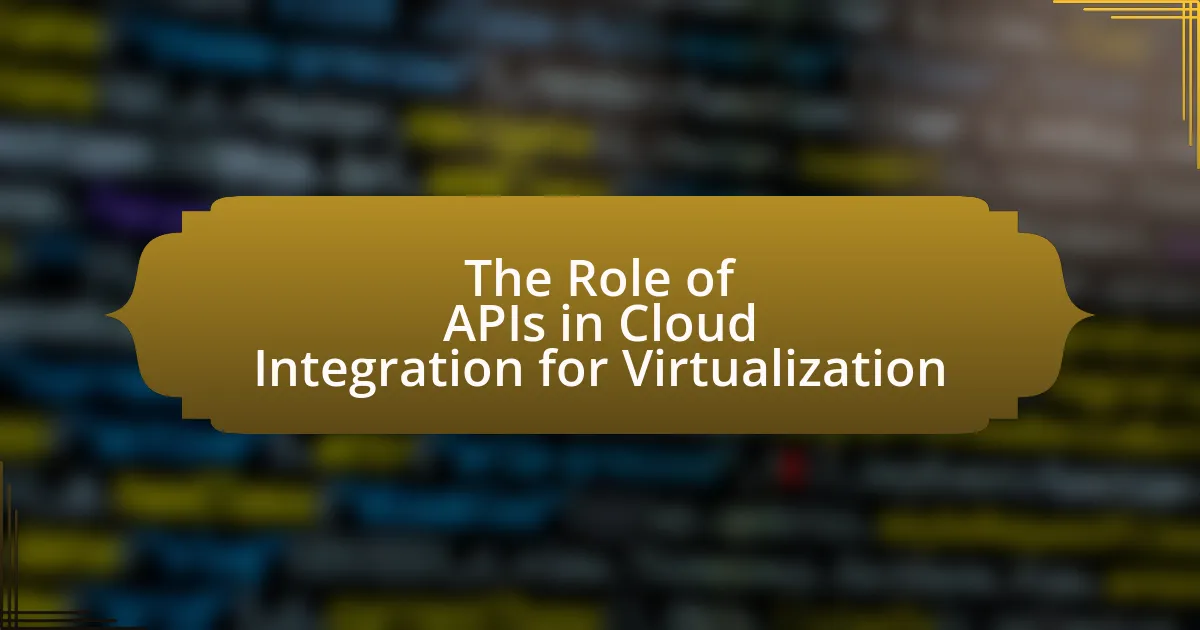Leveraging machine learning for enhanced cloud integration in virtualization focuses on utilizing advanced algorithms to optimize resource allocation, improve performance, and automate management tasks within virtualized cloud environments. The article explores how machine learning enhances operational efficiency through predictive analytics, dynamic resource scaling, and anomaly detection, leading to significant cost reductions. It discusses specific machine learning techniques such as supervised learning, unsupervised learning, reinforcement learning, and deep learning, and highlights the benefits of improved data processing and automation. Additionally, the article addresses challenges related to data privacy, integration complexity, and technical barriers, while outlining strategies for successful implementation and future trends in this evolving field.
What is Leveraging Machine Learning for Enhanced Cloud Integration in Virtualization?

Leveraging machine learning for enhanced cloud integration in virtualization involves utilizing advanced algorithms to optimize resource allocation, improve performance, and automate management tasks within virtualized cloud environments. Machine learning models analyze vast amounts of data generated by cloud operations, enabling predictive analytics that can forecast demand, detect anomalies, and streamline workflows. For instance, a study by Amazon Web Services demonstrated that machine learning can reduce operational costs by up to 30% through efficient resource management and predictive scaling. This integration not only enhances operational efficiency but also improves the overall user experience by ensuring that resources are allocated dynamically based on real-time needs.
How does machine learning enhance cloud integration in virtualization?
Machine learning enhances cloud integration in virtualization by optimizing resource allocation and improving operational efficiency. Through predictive analytics, machine learning algorithms can analyze usage patterns and forecast demand, allowing for dynamic scaling of resources in real-time. This capability reduces costs and minimizes downtime, as evidenced by a study from Gartner, which found that organizations leveraging machine learning for cloud resource management experienced up to a 30% reduction in operational costs. Additionally, machine learning enhances security in cloud environments by identifying anomalies and potential threats, thereby ensuring a more robust and secure virtualization infrastructure.
What specific machine learning techniques are utilized in this process?
The specific machine learning techniques utilized in the process of leveraging machine learning for enhanced cloud integration in virtualization include supervised learning, unsupervised learning, reinforcement learning, and deep learning. Supervised learning is often used for predictive analytics, enabling systems to forecast resource demands based on historical data. Unsupervised learning helps in clustering and anomaly detection, which is crucial for identifying unusual patterns in cloud resource usage. Reinforcement learning optimizes resource allocation by learning from the environment and making decisions that maximize efficiency. Deep learning, particularly through neural networks, enhances data processing capabilities, allowing for more sophisticated analysis of large datasets in cloud environments. These techniques collectively improve the efficiency, scalability, and reliability of cloud integration in virtualization.
How does machine learning improve resource allocation in virtualized environments?
Machine learning improves resource allocation in virtualized environments by enabling dynamic optimization of resource distribution based on real-time data analysis. This technology analyzes usage patterns, predicts future demands, and automates the allocation of CPU, memory, and storage resources to ensure efficient utilization. For instance, a study by Google demonstrated that machine learning algorithms could reduce resource wastage by up to 30% in cloud environments by accurately forecasting workload requirements and adjusting resources accordingly. This capability not only enhances performance but also reduces operational costs, making virtualized environments more efficient and responsive to changing demands.
What are the key benefits of leveraging machine learning in cloud integration?
Leveraging machine learning in cloud integration offers enhanced data processing, improved decision-making, and increased automation. Machine learning algorithms can analyze vast amounts of data in real-time, enabling organizations to derive actionable insights quickly. For instance, according to a report by McKinsey, companies that utilize machine learning in their cloud strategies can improve operational efficiency by up to 30%. Additionally, machine learning can automate routine tasks, reducing human error and freeing up resources for more strategic initiatives. This combination of speed, accuracy, and efficiency underscores the significant advantages of integrating machine learning into cloud environments.
How does this approach enhance operational efficiency?
This approach enhances operational efficiency by automating resource allocation and optimizing workload management through machine learning algorithms. Machine learning analyzes usage patterns and predicts resource needs, allowing for dynamic scaling of cloud resources, which reduces downtime and improves performance. For instance, a study by Amazon Web Services found that organizations using machine learning for cloud resource management experienced up to a 30% reduction in operational costs and a significant increase in system responsiveness.
What impact does it have on cost reduction for organizations?
Leveraging machine learning for enhanced cloud integration in virtualization significantly impacts cost reduction for organizations by optimizing resource allocation and automating processes. Machine learning algorithms analyze usage patterns and predict resource needs, allowing organizations to scale their cloud resources efficiently, which reduces unnecessary expenditures. For instance, a study by Gartner indicates that organizations can save up to 30% on cloud costs by implementing machine learning-driven optimization strategies. This data demonstrates that effective integration of machine learning not only streamlines operations but also leads to substantial financial savings.
What challenges are associated with implementing machine learning in cloud integration?

Implementing machine learning in cloud integration presents several challenges, including data privacy concerns, integration complexity, and resource management. Data privacy issues arise due to the sensitive nature of information processed in the cloud, necessitating compliance with regulations like GDPR. Integration complexity stems from the need to harmonize diverse data sources and systems, which can lead to increased development time and costs. Resource management challenges occur as machine learning models require significant computational power and storage, potentially leading to scalability issues and higher operational expenses.
What technical barriers must be overcome?
Technical barriers that must be overcome include data interoperability, scalability issues, and security concerns. Data interoperability challenges arise from the need for different systems and platforms to communicate effectively, which is crucial for seamless cloud integration. Scalability issues pertain to the ability of machine learning models to handle increasing amounts of data and user demands without performance degradation. Security concerns involve protecting sensitive data during transmission and storage, as well as ensuring compliance with regulations such as GDPR. Addressing these barriers is essential for successful implementation of machine learning in cloud virtualization environments.
How do data privacy and security concerns affect implementation?
Data privacy and security concerns significantly hinder the implementation of machine learning in cloud integration for virtualization. These concerns lead organizations to impose stringent data governance policies, which can restrict the types of data that can be utilized for training machine learning models. For instance, regulations such as the General Data Protection Regulation (GDPR) mandate that personal data must be processed lawfully, transparently, and for specific purposes, which complicates data collection and usage. Additionally, security vulnerabilities can deter organizations from adopting cloud solutions, as they fear potential data breaches that could expose sensitive information. A study by the International Data Corporation (IDC) found that 70% of organizations cite data security as a primary barrier to cloud adoption, illustrating the pervasive impact of these concerns on implementation strategies.
What are the limitations of current machine learning models in this context?
Current machine learning models in the context of leveraging machine learning for enhanced cloud integration in virtualization face several limitations. These limitations include issues with scalability, as many models struggle to efficiently process large datasets typical in cloud environments, leading to increased latency and resource consumption. Additionally, current models often lack robustness, making them sensitive to variations in data quality and distribution, which can result in degraded performance when applied to real-world scenarios. Furthermore, interpretability remains a challenge; many complex models operate as “black boxes,” making it difficult for users to understand decision-making processes, which is critical for trust and compliance in cloud applications. Lastly, the reliance on labeled data for training can hinder the adaptability of models in dynamic cloud environments, where data may frequently change or be unlabeled.
How can organizations effectively address these challenges?
Organizations can effectively address challenges in leveraging machine learning for enhanced cloud integration in virtualization by implementing a structured approach that includes investing in skilled personnel, adopting robust data management practices, and utilizing advanced machine learning algorithms. Skilled personnel are essential for developing and maintaining machine learning models, as evidenced by a report from McKinsey, which states that companies with a strong data science team are 2.5 times more likely to achieve significant business impact from AI initiatives. Robust data management practices ensure high-quality data is available for training models, which is critical since poor data quality can lead to inaccurate predictions. Furthermore, utilizing advanced machine learning algorithms tailored for cloud environments can optimize resource allocation and improve system performance, as demonstrated by research from the IEEE, which highlights the efficiency gains from using specific algorithms in cloud-based applications.
What strategies can be employed to ensure data security?
To ensure data security, organizations can implement strategies such as encryption, access controls, and regular security audits. Encryption protects data by converting it into a coded format that can only be read by authorized users, thereby safeguarding sensitive information from unauthorized access. Access controls limit who can view or manipulate data, ensuring that only individuals with the necessary permissions can interact with critical information. Regular security audits help identify vulnerabilities and ensure compliance with security policies, allowing organizations to proactively address potential threats. According to a report by the Ponemon Institute, organizations that employ these strategies can reduce the risk of data breaches significantly, highlighting their effectiveness in maintaining data security.
How can organizations choose the right machine learning models for their needs?
Organizations can choose the right machine learning models for their needs by assessing their specific objectives, data availability, and the complexity of the problem. First, they should clearly define the problem they aim to solve, such as classification, regression, or clustering. Next, they must evaluate the quality and quantity of their data, as different models require varying amounts of data for effective training. For instance, deep learning models typically need large datasets, while simpler models like decision trees can perform well with less data. Additionally, organizations should consider the interpretability of the model; for example, linear models are easier to interpret than complex neural networks. Finally, they should conduct experiments with multiple models and validate their performance using metrics relevant to their objectives, such as accuracy, precision, or recall, to ensure the selected model meets their specific needs.
What are the future trends in leveraging machine learning for cloud integration in virtualization?

Future trends in leveraging machine learning for cloud integration in virtualization include enhanced automation, predictive analytics, and improved resource management. Automation will streamline deployment and scaling processes, reducing human intervention and errors. Predictive analytics will enable proactive management of cloud resources by forecasting demand and optimizing performance, as evidenced by studies showing that organizations using machine learning for resource allocation can achieve up to 30% cost savings. Improved resource management will involve intelligent load balancing and dynamic resource allocation, ensuring optimal performance and efficiency in virtualized environments. These trends reflect the growing integration of machine learning capabilities into cloud infrastructure, driving innovation and operational excellence.
How is the role of artificial intelligence evolving in this space?
The role of artificial intelligence is evolving significantly in the context of leveraging machine learning for enhanced cloud integration in virtualization. AI technologies are increasingly being integrated into cloud services to optimize resource allocation, improve performance, and enhance security measures. For instance, AI algorithms can analyze vast amounts of data in real-time to predict workload demands, enabling dynamic scaling of resources in cloud environments. This evolution is supported by research indicating that organizations utilizing AI-driven analytics in cloud integration can achieve up to a 30% reduction in operational costs and a 40% improvement in resource utilization efficiency.
What advancements in machine learning are expected to impact cloud integration?
Advancements in machine learning expected to impact cloud integration include improved algorithms for data processing, enhanced predictive analytics, and automated resource management. These advancements enable more efficient data handling and real-time decision-making, which are crucial for cloud environments. For instance, the development of federated learning allows models to be trained across decentralized data sources without compromising privacy, thus facilitating better integration of cloud services. Additionally, advancements in natural language processing enhance user interactions with cloud platforms, making it easier to manage and retrieve data. These innovations collectively streamline operations and improve the scalability of cloud solutions.
How will emerging technologies influence virtualization practices?
Emerging technologies will significantly enhance virtualization practices by enabling more efficient resource allocation and improved performance. For instance, advancements in machine learning algorithms allow for predictive analytics, which can optimize workload distribution across virtual machines, leading to reduced latency and better utilization of hardware resources. Additionally, technologies such as edge computing facilitate the deployment of virtualized services closer to end-users, enhancing response times and overall user experience. According to a report by Gartner, organizations that leverage machine learning in their virtualization strategies can achieve up to 30% better resource efficiency, demonstrating the tangible benefits of integrating these emerging technologies into virtualization practices.
What best practices should organizations follow when implementing these technologies?
Organizations should prioritize a structured approach when implementing machine learning technologies for enhanced cloud integration in virtualization. This includes conducting a thorough needs assessment to identify specific business objectives and aligning machine learning initiatives with these goals. Additionally, organizations should invest in robust data management practices to ensure high-quality, relevant data is available for training machine learning models.
Furthermore, establishing a cross-functional team that includes IT, data science, and business stakeholders can facilitate better communication and collaboration throughout the implementation process. Regularly monitoring and evaluating the performance of machine learning models is essential to ensure they meet the desired outcomes and can be adjusted as necessary.
Finally, organizations should prioritize security and compliance by implementing best practices for data protection and adhering to relevant regulations, as this is critical in maintaining trust and safeguarding sensitive information.
How can organizations ensure successful integration of machine learning in their cloud strategies?
Organizations can ensure successful integration of machine learning in their cloud strategies by establishing a clear framework that aligns machine learning initiatives with business objectives. This involves identifying specific use cases where machine learning can add value, such as predictive analytics or automated decision-making, and ensuring that the necessary data infrastructure is in place to support these applications.
Furthermore, organizations should invest in training and upskilling their workforce to effectively utilize machine learning tools and platforms. According to a report by McKinsey, companies that prioritize talent development in AI and machine learning see a 20% increase in project success rates. Additionally, adopting a cloud-native architecture facilitates scalability and flexibility, allowing organizations to leverage cloud resources efficiently for machine learning workloads.
Regularly evaluating and iterating on machine learning models based on performance metrics is also crucial, as it ensures that the models remain relevant and effective over time. By following these steps, organizations can create a robust environment for integrating machine learning into their cloud strategies.
What common pitfalls should be avoided during implementation?
Common pitfalls to avoid during implementation of machine learning for enhanced cloud integration in virtualization include inadequate data quality, insufficient stakeholder engagement, and lack of clear objectives. Inadequate data quality can lead to inaccurate model predictions, as machine learning algorithms rely heavily on the data they are trained on. Insufficient stakeholder engagement may result in misalignment between technical teams and business goals, causing project delays or failures. Lastly, a lack of clear objectives can lead to scope creep and ineffective resource allocation, ultimately undermining the project’s success. Addressing these pitfalls is crucial for achieving effective integration and maximizing the benefits of machine learning in cloud environments.




